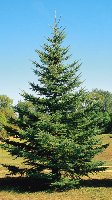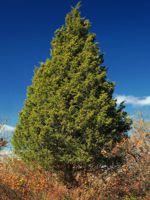Mon-Fri 9am - 5pm Mountain time
Black Hills Spruce vs Eastern Red Cedar
Picea glauca var. densata
Juniperus virginiana
NOT AVAILABLE THIS SEASON - MIGHT RETURN
Black Hills Spruce is a subspecies of White Spruce native to the Black Hills of South Dakota. It has a strongly conical form, slower growth rate and denser foliage than typical white spruce, making it preferable as a specimen tree for smaller suburban lawns. It also responds well to pruning, and can be used as a hedge or even bonsai.
Eastern Red Cedar is native to eastern Canada and is actually a variety of juniper, not cedar. Its pyramidal crown, low hanging branches, and dense, compact foliage makes it an ideal windbreak or shelterbelt tree.
Eastern Red Cedar will attract wildlife to your yard and provide food and shelter for multiple varieties of birds. If you are on the east coast looking to create a windbreak, consider Eastern Red Cedar.
Black Hills Spruce Quick Facts
Eastern Red Cedar Quick Facts
In row spacing: 3 - 4 m (10 - 12 ft)

